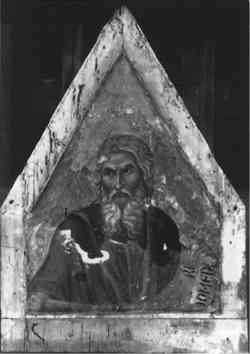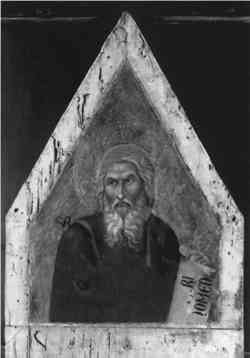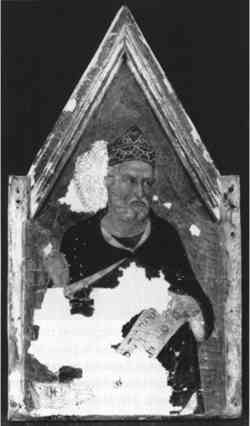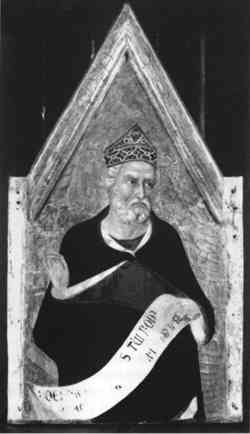THE RESTORATION OF THE EARLY ITALIAN “PRIMITIVES” DURING THE 20TH CENTURY: VALUING ART AND ITS CONSEQUENCES
CATHLEEN HOENIGER
5 RETHINKING AND COMPROMISE IN THE 1970s AND 1980s
In more recent decades, restorers have begun to re-evaluate the exclusive desire for so-called honesty reflected in the post-World War II cleanings just discussed. Indeed, some treatments carried out at the National Gallery in London reveal attempts to reach compromises between honesty, in respect to a painting's condition, and necessity, in respect to allowing the painting to communicate both iconographically and as an aesthetic object.
Movement toward compromise can be seen in the restoration of fragments from Ugolino di Nerio's Sta. Croce Polyptych, for example. Several heavily damaged portions from this Sienese altrapiece of about 1324–25 were partially reconstructed in two separate campaigns during the early 1970s and the mid-1980s. The pinnacle panel of Isaiah, cleaned in 1970, demonstrates how extensive, disfiguring paint losses, particularly evident in the drapery, were inpainted using matching neutral fields of color but without redrawing the inscriptions, the modeling of the drapery, or the lost portions of Isaiah's hands (figs. 9, 10). When the David panel from the same altarpiece was restored between 1983 and 1984, however, more liberty was taken to recreate the spirit of the original by redrawing compositional outlines in a general way, and reconstructing the losses to the gilded background, including the ornamentation of the halo in an abbreviated form (figs. 11, 12). The intention of the 1983–1984 restoration, as Anthony Reeve has remarked, was “to reduce but not to disguise the distracting effects of the damage” (Gordon and Reeve 1984, 51). Inpainting was carried out using matching neutral fields of color, but the restorers were careful to preserve the distinction between what remained of the original and their contributions.
Fig. 9.
Ugolino di Nerio, Isaiah from the Sta. Croce Polyptych, ca. 1324–25, egg tempera (analyzed) on poplar, 46 � 32 cm, 18 1/8 � 12 5/8 in., during the restoration of 1970. Collection of the National Gallery, London, no. 3376. Courtesy of the Trustees
 |
Fig. 10.
Ugolino di Nerio, Isaiah, after the restoration of 1970
 |
Fig. 11.
Ugolino di Nerio, David from the Sta. Croce Polyptych, ca. 1324–25, egg tempera (analyzed) on poplar, 55.3 � 31.1 cm, 21 3/4 � 12 1/4 in., during the restoration of 1983–1984. Collection of the National Gallery, London, no. 6485. Courtesy of the Trustees
 |
Fig. 12.
Ugolino di Nerio, David, after the restoration of 1983–1984
 |
|



